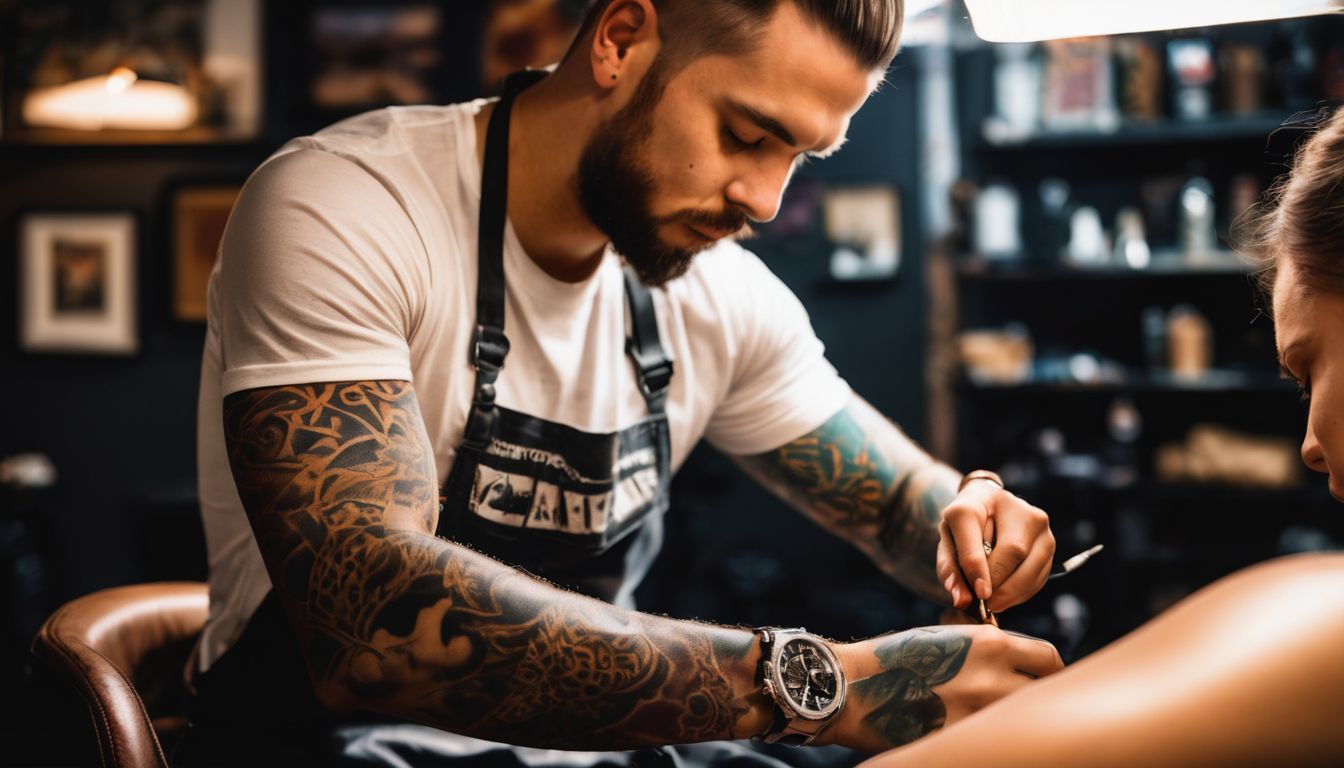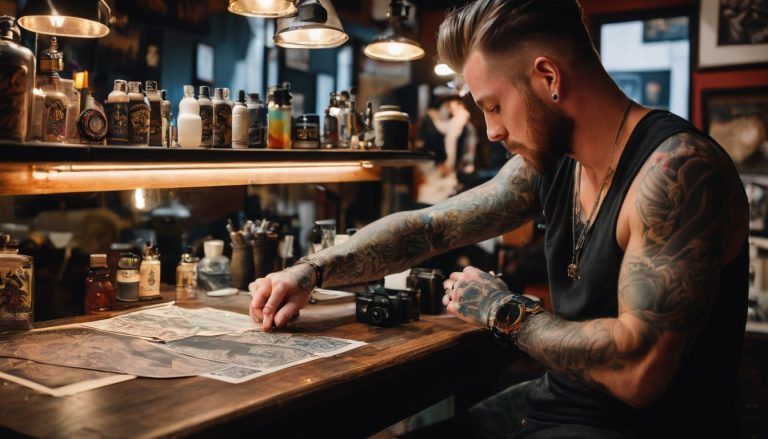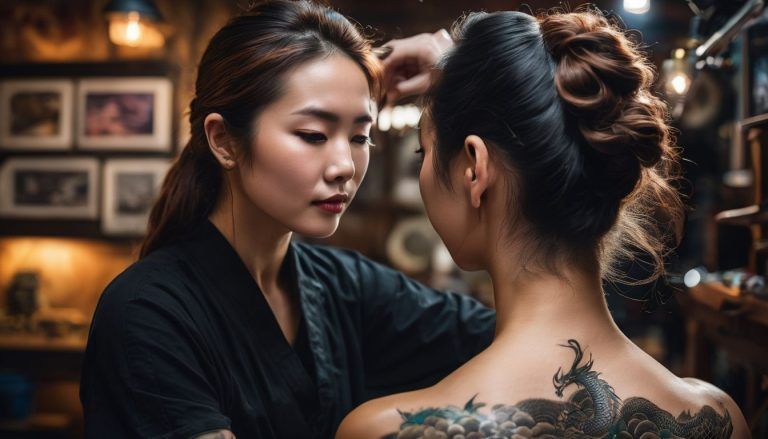The Ultimate Guide to Tattoo Stencils: How to Find, Use, and Create Your Own
Are you struggling to get your tattoo designs just right? Tattoo stencils are key tools that help artists transfer intricate patterns onto the skin accurately. Our ultimate guide will show you where to find, use, and even make your own stencils for flawless tattoos every time.
Keep reading – it’s easier than you think!
Key Takeaways
- Tattoo stencils are crucial for transferring accurate and detailed designs onto the skin; they come in different types like thermal transfer paper, freehand, carbon stencils, stencil machines, and pre-made options.
- Quality tattoo stencils allow artists to avoid mistakes and ensure the design is transferred correctly; factors like size, complexity, skin sensitivity, longevity of the stencil’s ink or dye on the skin before application matter when choosing a stencil.
- To use a tattoo stencil properly involves preparing the skin surface cleanly, applying pressure evenly with moistened sponge over transfer paper on desired area for about 10 seconds then lifting carefully once dried.
- Creating custom tattoo stencils gives artists flexibility to create unique body art by using materials such as transfer paper and hand drawing tools or printers; techniques include sketching bold lines for clear transfers and applying gel for better adhesion.
- Artists need to consider client preferences for customization when creating a successful tattoo from quality stencils that fit body contours accurately.
Understanding Tattoo Stencils
Tattoo stencils are essential tools for tattoo artists to create precise, detailed designs on their clients. They come in various types and are crucial for ensuring the accuracy of a tattoo’s placement and design.
Understanding the importance and different types of tattoo stencils is vital before finding, using, or creating your own.
What are tattoo stencils?
Tattoo stencils are a vital tool for any tattoo artist, serving as a blueprint for the permanent artwork they will ink on the skin. They provide an outline of the design that ensures accuracy and helps clients visualize how their body art will look once completed.
Made from special paper or through printers designed for stencil creation, these templates can be intricate patterns or simple shapes depending on the complexity of the design.
Artists use these guides to transfer tattoo outlines onto a person’s skin before starting with needles and inks. This step is crucial because it lays down a path that guides the hand throughout each detailed line and shading area of the tattoo drawing process.
By using a stencil, professionals avoid mistakes and uneven lines which could compromise the quality of the finished piece. Stencils vary in type—from ready-to-use options to custom designs created by tracing over original artwork—offering versatility for every kind of tattoo project whether it’s traditional, tribal, or contemporary styles.
Why are they important?
Tattoo stencils are crucial for achieving precise and professional-looking designs. They act as a guide for tattoo artists, ensuring accuracy in placement and detail. The use of tattoo stencils also minimizes the risk of mistakes, providing a clear outline for the artist to follow during the tattooing process.
Additionally, quality stencils help maintain consistency in design, allowing artists to replicate patterns or images accurately. For clients, this means receiving the exact design they desire with minimal room for error.
Moreover, using tattoo stencils enables artists to streamline their workflow and enhance efficiency. By having a clear template to work from, they can focus on perfecting the execution of the tattoo rather than spending excessive time on freehand drawing.
Types of tattoo stencils
Tattoo stencils are essential tools for tattoo artists, allowing them to transfer designs onto the skin before inking. There are different types of tattoo stencils available, each serving a specific purpose and catering to diverse preferences within the tattooing community.
- Thermal Transfer Paper: This type of stencil is widely used in professional tattooing. It involves using a thermal copier to transfer the design to be inked onto the client’s skin.
- Freehand Stencils: These are created directly on the client’s skin by the artist using markers or pens, offering a more personalized and unique approach to tattoo design application.
- Carbon Stencils: Utilizing carbon-based transfer paper, these stencils provide a reliable and durable option for transferring intricate designs onto the skin.
- Stencil Machines: These machines speed up the process by printing out precise stencils created digitally or manually by the artist.
- Pre-made Stencils: Ready-to-use stencil templates come in various designs, enabling artists to work efficiently and cater to clients looking for popular or traditional tattoo patterns.
Finding the Right Tattoo Stencil
When looking for the right tattoo stencil, consider factors such as quality and customization. Sources for stencils can vary, so it’s important to choose one that meets your specific needs and preferences.
Sources for stencils
When looking for tattoo stencils, consider the following sources:
- Professional Tattoo Supply Stores: These stores offer a wide range of pre-made stencil templates suitable for various designs and applications.
- Online Marketplaces: Websites such as Etsy and Amazon provide access to a diverse selection of tattoo stencil templates, including unique and customizable options.
- Tattoo Artist Workshops: Many tattoo artists offer workshops where enthusiasts can learn how to create their own stencils or purchase custom designs directly from the artist.
- Tattoo Design Apps: Certain mobile applications allow users to browse through a plethora of tattoo stencil templates, offering convenient access to a myriad of design options.
- Custom Stencil Services: Some companies specialize in creating personalized tattoo stencils tailored to an individual’s specific requirements, providing a unique and one-of-a-kind option for discerning clients.
Factors to consider
When finding the right tattoo stencil, consider the following factors:
- Size and Placement: Ensure the stencil is appropriate in size for the intended placement on the body, considering factors such as curves and contours.
- Design Complexity: Consider the intricacy of the design and how well it translates onto the skin using a stencil.
- Skin Sensitivity: Take into account any skin allergies or sensitivities when selecting a tattoo stencil to avoid adverse reactions.
- Longevity: Assess the durability of the stencil, particularly if it needs to last for an extended period before application.
- Customization Options: Look for stencils that offer room for customization to meet specific client preferences or unique design elements.
- Application Technique: Consider whether the desired stencil aligns with your preferred application technique, such as manual hand-drawn stencils or machine-generated ones.
- Source Reliability: Evaluate the reliability and reputation of sources offering ready-to-use stencils to ensure quality and authenticity.
- Adaptability: Look for stencils that can be easily adjusted or modified during application to accommodate client feedback or alterations.
Quality and customization
When considering tattoo stencils, quality is crucial for achieving a precise and long-lasting design. Ensuring that the stencil material is durable and can withstand the application process is essential in creating professional-looking tattoos.
Customization also plays a significant role, allowing tattoo artists to tailor stencils to fit the client’s unique body contours or specific design preferences. The ability to customize stencils ensures that the final tattoo placement and composition align perfectly with the client’s vision, leading to greater satisfaction.
Moving on to how customization impacts the overall aesthetic of the tattoo..
How to Use Tattoo Stencils
Learn the step-by-step process for using tattoo stencils and discover tips for application and placement to achieve the perfect body art. Read on to master the art of tattoo stenciling.
Step-by-step process
To create a tattoo stencil, you will need transfer paper, a thermal copier or a pencil, and your chosen design.
- Select the design for your tattoo stencil and print it or draw it by hand onto the transfer paper using a pencil.
- Place the stencil paper with your design against the skin where you want the tattoo.
- Use a moist sponge to dampen the skin before applying pressure evenly over the entire stencil for about 10 seconds.
- Carefully lift one corner of the transfer paper and check if the entire design has transferred onto the skin.
- Once transferred, remove the transfer paper gently and allow sufficient time for it to dry completely before starting to ink.
- If there are any smudges or incomplete lines, carefully touch up with a fine – tipped pen or marker as necessary.
Tips for application and placement
- Clean and prepare the skin surface to ensure the stencil adheres effectively.
- Choose a flat, unobstructed area on the body that will showcase the tattoo design.
- Smooth out the stencil carefully to prevent creases or air bubbles that could distort the design.
- Make sure the stencil is positioned correctly by comparing it with reference points on the body.
- Secure the edges of the stencil with tape or adhesive to prevent movement during the tattooing process.
- Double – check the placement from different angles to ensure alignment and symmetry with the body’s contours.
- Communicate with the client about their comfort and satisfaction with the placement before proceeding with tattooing.
Creating Your Own Tattoo Stencil
Learn how to create your own custom tattoo stencils using the right tools and techniques, and unleash your creativity onto the skin – it’s easier than you think! Read on to discover everything you need to know about tattoo stencils.
Tools and materials needed
To create your own tattoo stencil, you’ll need a few essential tools and materials. Here’s what you’ll need:
- Tattoo Transfer Paper: Use this paper to transfer the design onto the skin.
- Design or Image: Have a clear, high-quality image of the tattoo design you want to transfer.
- Printer or Hand Drawing Tools: Depending on whether you’re using a stencil printer or creating the stencil by hand, you’ll need either a printer or drawing tools such as tracing paper and markers.
- Thermal Copier (Optional): If you’re using a thermal copier, make sure to have one available for transferring the design onto the transfer paper.
- Skin Preparation Products: Ensure that the skin is clean and free from any oils before applying the stencil.
Techniques for design and transfer
To design and transfer a tattoo stencil, follow these techniques:
- Sketch the design on transfer paper using a stencil pencil or ballpoint pen.
- Ensure the lines are bold and clear to facilitate transfer onto the skin.
- Apply a generous amount of stencil transfer gel or solution to the skin where the tattoo will be placed.
- Press the transfer paper firmly against the skin and hold for a few seconds before carefully removing it.
- Gently pat the area with a clean cloth to reveal the transferred stencil on the skin.
- Refine any faint lines with a fine – tipped pen before beginning the tattoo application process.
Conclusion
In conclusion, mastering tattoo stencils is crucial for any artist. Whether finding the perfect stencil or creating a custom design, it’s essential to consider quality and customization options.
Understanding these nuances and techniques can set you apart in the world of tattoo artistry. With the right tools and know-how, artists can create unique and long-lasting designs that satisfy both themselves and their clients.
Ultimately, becoming proficient in using and creating tattoo stencils opens up new creative possibilities while enhancing professional skills.
FAQs
1. What are tattoo stencils?
Tattoo stencils are tools tattoo artists use to transfer designs onto skin before inking, ensuring precise and accurate body art.
2. Where can I find quality tattoo templates?
You can find quality tattoo templates at specialist tattoo artist resources shops, or online stores that sell tattoo supplies and equipment.
3. How do I use a stencil for a tattoo?
To use a stencil, clean the skin properly, place the ink stencil on it, apply pressure to transfer the design, then remove the template carefully to start inking over it.
4. Can I create my own tattoo flash?
Yes, you have the freedom to create your own custom ink stencils using tracing paper or specialized software designed for creating permanent markings.
5. Why is it important for a tattoo artist to use stencils?
Using stencils is crucial as they help ensure that tattoos are accurately portrayed from the design onto clients’ skin and reflect true-to-concept artwork within the rich tapestry of tattoo culture.










